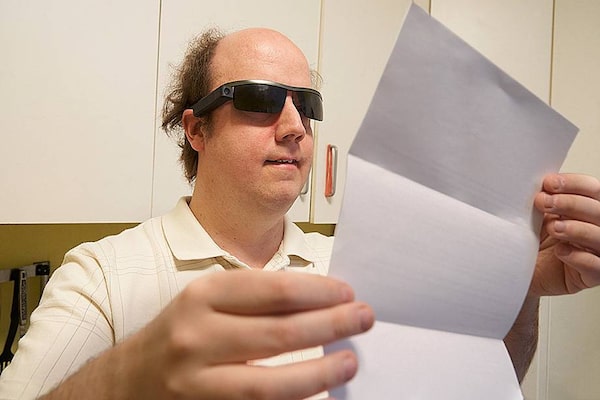
CNIB tech lead Jason Fayre tries Aira, which uses a device attached to glasses that lets an agent see for the wearer through a smartphone app.
Imagine not being able to read a soup can label, a letter from your favourite relative, or the price of an item of clothing at the store – those are the challenges faced every day by those with visual impairments.
But new apps and technologies are meeting that challenge and the Canadian National Institute for the Blind, which is marking its centennial this year, is helping to get these inventions into the hands of those who need them.
Jason Fayre, who is national lead for accessibility and assistive technology at CNIB, evaluates new tech for the organization and says it's developing at a rapid pace, giving the blind and partially sighted greater access to information and communication than ever before.
"It's a huge influence," he says.
For example, where software that would read text aloud was once only found on bulky computers, it's now widely available on smartphones, which also have screen magnification and many other helpful apps.
"If I've got a can of soup and I want to know what it is, I can scan the bar code off that can and it will read to me what that item is," he says of Microsoft's free Seeing AI app, for example.
Another is the Aira service, which attaches a tiny device to a pair of glasses and allows an agent to see for the wearer when they contact Aira via a smartphone app.
"Let's say I go to a mall and I want to know where a particular store is," Mr. Fayre says. "I can call the agent, they can see where I am, they can pull up a map of the mall and actually guide me to a location. Or I can use that for reading mail or matching clothing … a lot of things can be accomplished by this service."
There are some challenges with technology. Cost can be a factor, although most apps are free, as well as accessibility to training in remote areas and the lack of knowledge by some that a particular technology exists.
Dr. Alan Berger, a retinal surgeon at St. Michael's Hospital in Toronto, says technological innovations have helped in the diagnosis and treatment of vision disorders.
Among the groundbreaking technology, he also points to the Argus 2 retinal prosthesis, which has been described as "the bionic eye."
The Argus uses a tiny video camera and an electrode implant to help the retina's remaining cells create the perception of light patterns for the wearer.
"It sends impulses to this electrode inside the eye, which then passes the images back to the occipital cortex – the visual part of the brain," he explains.
Many basic things also help the legally blind, Dr. Berger says, citing increased magnification and brighter illumination and contrast on devices.
"Everything's been progressing exponentially in terms of how small, how light, how easy they are to use," says Dr. Berger, who is also vice-chairman of clinical services for the Department of Ophthalmology and Vision Sciences at the University of Toronto.
Despite the wonders of technology, however, Mr. Fayre says service dogs need never fear for their jobs.
"There are tools that will help you navigate but nothing is going to replace your brain," he says.
"Nothing is going to replace a cane or a dog or good mobility skills anytime soon."
Advertising produced by The Globe Content Studio. The Globe's editorial department was not involved in its creation.